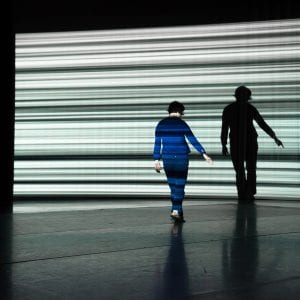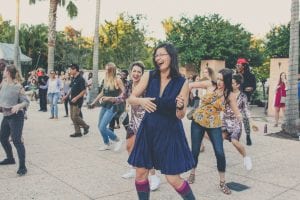October 8, 2019 | By Amanda Sieradzki
Breaking Down the “Score” with Andee Scott
Friday, October 11 at 7:30 pm
The Studio@620
Details here

The Studio@620’s Dance Hall Festival continues to bring movement into the month of October. In the midst of numerous dance concerts and fall shows, USF dance professor and choreographer Andee Scott is questioning what audiences are actually seeing when witnessing dance performances.
Her experiment — What’s the Score — hopes to unlock that question and provide a framework for understanding movement as it unfolds in real time.
Scott is inspired by the work of dance-maker, videographer and improviser, Lisa Nelson. Nelson developed an approach to spontaneous composition titled Tuning Scores, which gives dancers a set of tasks that in turn create on-the-spot performances.
Scott will bring these scores to life with the help of collaborators Clare Croft, Pamela Pietro and Heidi Brewer to connect with the audience and give us the tools for understanding contemporary dance movement.
The Arts Coast Journal spoke with Scott about her play-by-play approach and what audiences can expect during this barrier breaking experiment.

How are you defining a ‘score’ when it comes to dance?
The score is content or context for something to be perceived. Lisa Nelson’s scores are tasks that warm up the imagination and the senses so that we can be primed to watch a dance.
I would like to use the scores to warm up the audience so we that we can begin to understand the role that our eyes play in watching dance.
I am leading the audience through the scores and creating a situation where we can all participate in the scores in a practical way, and then talk about what we’re seeing.
What is an example of a score?
One task is observing synchronicity. Three people are moving with their eyes closed trying to be in unison — which is an impossible task but (lets) the audience raise their hands when they see synchronicity.
What you notice begins to crystallize because not everybody notices the same thing. That helps us find our own way into what is happening and perhaps begin a process of revealing what we see.
There’s also a score about a playback, which we might do as well. One dancer does a dance and the other dancers go into the space and replay what they saw.
You start to see that everybody takes something completely different from what they’re watching. Someone might be attaching to a spatial pattern or dynamic shift or shape in space.
I think in that way we also have freedom to like what we want and see what we want.

Why is opening up a conversation about dance like this with audiences important to you?
Sometimes we set it up that when you watch a dance the task is to figure it out, but I don’t know if that is productive or true.
The scores provide agency for an audience who have a task to do while they are watching, but it doesn’t involve trying to figure out what’s going on. . . Is there a way to create a situation where someone is able to leave with more connections and abilities to make meaning? Is there a way that we can provide people with more access points into watching something?
Human beings are all movement experts. We know not to get hit by a car, or when someone is about to say hello to us or not say hello to us. We read situations all the time.
This [experiment] seems like a way to take away the hierarchy. Dance doesn’t have to be a story. It can be about space and time. It can be about the relationship and connection between things. So, can we talk about what is actually happening and what does that story feel like?

What do you hope for the people who participate in this experiment?
I want people to expect a performance when they come because I want them to be ready to watch things happen in real time.
I do want to facilitate part of it as it’s happening and give suggestions on what to look for, then we are all on our own and have time to talk and process.
It would be really great for people to have more access to perception, and know that it is something they are already doing.
Find out more about
Andee Scott’s work here
Listen to Andee Scott
on aging as a dancer and exploring
our humanity through movement on Arts In


